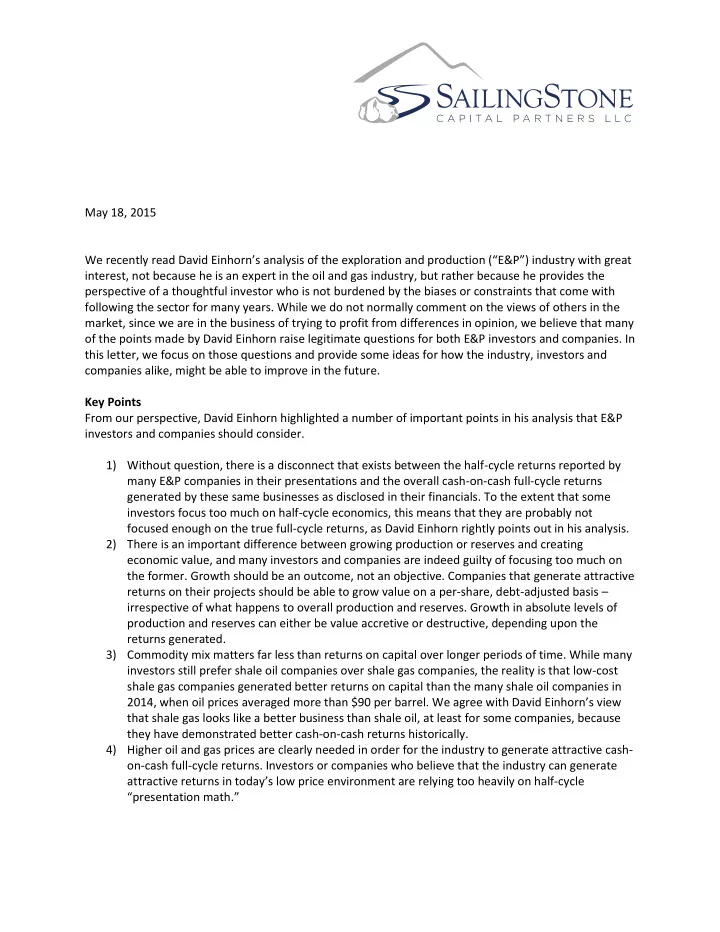

May 18, 2015 We recently read David Einhorn’s analysis of the exploration and production (“E&P”) industry with great interest, not because he is an expert in the oil and gas industry, but rather because he provides the perspective of a thoughtful investor who is not burdened by the biases or constraints that come with following the sector for many years. While we do not normally comment on the views of others in the market, since we are in the business of trying to profit from differences in opinion, we believe that many of the points made by David Einhorn raise legitimate questions for both E&P investors and companies. In this letter, we focus on those questions and provide some ideas for how the industry, investors and companies alike, might be able to improve in the future. Key Points From our perspective, David Einhorn highlighted a number of important points in his analysis that E&P investors and companies should consider. 1) Without question, there is a disconnect that exists between the half-cycle returns reported by many E&P companies in their presentations and the overall cash-on-cash full-cycle returns generated by these same businesses as disclosed in their financials. To the extent that some investors focus too much on half-cycle economics, this means that they are probably not focused enough on the true full-cycle returns, as David Einhorn rightly points out in his analysis. 2) There is an important difference between growing production or reserves and creating economic value, and many investors and companies are indeed guilty of focusing too much on the former. Growth should be an outcome, not an objective. Companies that generate attractive returns on their projects should be able to grow value on a per-share, debt-adjusted basis – irrespective of what happens to overall production and reserves. Growth in absolute levels of production and reserves can either be value accretive or destructive, depending upon the returns generated. 3) Commodity mix matters far less than returns on capital over longer periods of time. While many investors still prefer shale oil companies over shale gas companies, the reality is that low-cost shale gas companies generated better returns on capital than the many shale oil companies in 2014, when oil prices averaged more than $90 per barrel. We agree with David Einhorn’s view that shale gas looks like a better business than shale oil, at least for some companies, because they have demonstrated better cash-on-cash returns historically. 4) Higher oil and gas prices are clearly needed in order for the industry to generate attractive cash- on-cash full-cycle returns. Investors or companies who believe that the industry can generate attractive returns in toda y’s low price environment are relying too heavily on half -cycle “presentation math.”
SailingStone Capital Partners LLC May 18, 2015 Page 2 At the same time, it is also worth highlighting some of the important points that we feel David Einhorn did not adequately address in his analysis. 1) There are significant differences in the returns generated by E&P companies. Returns vary meaningfully between projects, both between basins and within a basin. While some shale oil companies have destroyed value, many E&P companies have created quite a bit of economic value for their owners. For instance, the cash-on-cash full-cycle returns generated by what David Einhorn refers to as the “Mother - Fracker” (Pioneer Natural Resources) are very different than the cash-on- cash returns generated by the “Father - Fracker” ( EOG Resources). Furthermore, some of the better-performing stocks in the market over long periods of time have been E&P companies that have generated very attractive returns and seen the economic value of their businesses compound. 2) There are differences in the metrics that are used by E&P company boards to evaluate and compensate management teams in the sector. While many management teams are overly focused on growth in production and reserves, others are appropriately focused on returns and creating economic value across the cycle. 3) There are meaningful differences in how E&P companies are currently being valued in the public equity market. While some companies do indeed appear to discount a significant portion of their future drilling inventory, many others do not. In fact, many E&P companies appear to be trading well below their private-market values, in our view. The gap in valuations that exists today between companies is as wide as we have seen it in a very long time. While the industry is not nearly as uniformly value destructive as David Einhorn suggests, there is no doubt that it can do better. Below are a few of our suggestions for E&P investors and companies. For E&P Investors Unfortunately, many E&P investors continue to allocate capital based on views regarding variables that we view as having absolutely nothing to do with longer-term value creation, including the short-term direction of commodity prices, arbitrary cash flow multiples, and, of course, production and reserves growth. Many of these investors are in the business of renting stocks to express an opinion about one of these factors, driven in part by short-term incentive compensation schemes. While these variables can influence short-term performance, ultimately we expect the market to be efficient and E&P stocks to track changes in economic value. Often times, the investors that push for higher rates of production growth sell their stakes before the economic consequences of their recommendations become obvious. Longer-term investors in E&P companies are then left to suffer the potential effects associated with what frequently is a gross misallocation of capital. Even worse, the focus on growth over returns leads to overinvestment during periods of cyclical strength and underinvestment during periods of weakness. This behavior, which has a funny way of repeating itself, helps create the boom and bust cycles that characterize the sector. In short, the pro- cyclical behavior of investors probably increases the magnitude of cyclical fluctuations and helps limit the value that is created by many companies in the oil and gas industry.
Recommend
More recommend